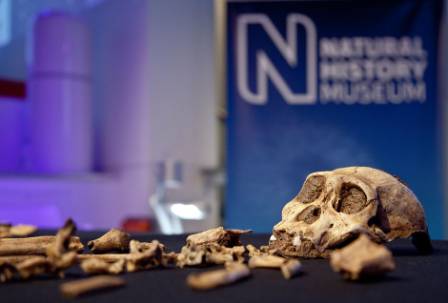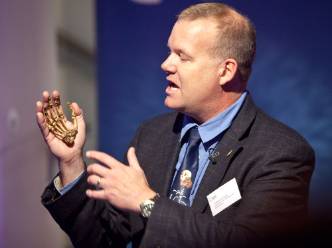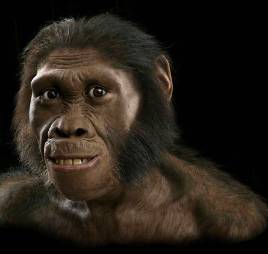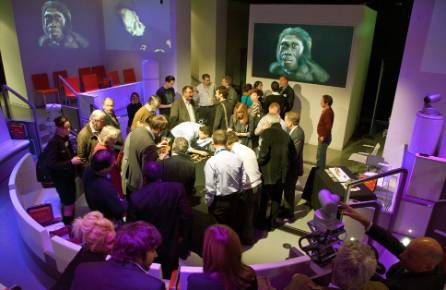'We have not explored this planet!' announced Professor Lee Berger excitedly earlier this week at the handover presentation here (pictured below) of the replicas of two 1.98 million-year-old early human fossil skeletons for our research.
The remarkable fossils belong to the ancient human-like species, Australopithecus sediba, which could be the ancestor to the first humans. The two replica casts, one an adult female and the other a young adolescent male skeleton, have been donated by the University of the Witwatersrand and the Government of the Republic of South Africa. The cast of the male skull - the female skull is still missing - went on public display in the Museum this week.
Prof Berger (below left) is lead palaeoanthropological researcher with the University of Witwatersrand's Institute for Human Evolution in Johannesburg. In his presentation he told us how Google Earth had inadvertently led his team to new archaeological locations and the subsequent discovery of 600 caves and fossil sites around Johannesburg, including Malapa.
Left: Prof Lee Berger demonstrates the human-like hand of the female specimens found. Right: 3D model created by paleo-artist John Gurche of the young male skull (Gurche's model recently won a palaeontology award). The male skeleton has been named Karabo (meaning 'the answer') by the local Malapa people.
Prof Berger spoke of the historic moment on 15 August 2008 when, after 17 years of digging, his nine-year-old son spotted the tip of a clavicle in the rock that turned out later to belong to one of the most complete early human skeletons ever found. 'When he pointed it out, I almost didn't want to look, for fear it would be just another antelope fossil!' Apparently as many as 250,000 antelope fossils are discovered for every one hominid fossil.
You can read more about the replica casts arriving here in our news story and the media. BBC News online described it as 'currently the hottest topic in palaeoanthropology'.
Scientists and journalists gather around to view the Malapa Cave Sediba fossils donated to the Museum at the recent presentation in the Attenborough Studio.
During Prof Berger's discussion with our own human origins expert Prof Chris Stringer it became clear that the finds at Malapa are set to reveal a lot more in the future, not only because of the light they shed on the evolution of modern humans (Homo sapiens), but because of their potentially mummified nature (the protein keratin may exist) and the way they can be so accurately dated. It is likely that they will unearth more in Malapa, and when asked what he would like to find next, Prof Berger replied, 'our female's skull... and a complete foot.'
You can see the Australopithecus sediba replica skull cast now on special display in Dinosaur Way at the Museum. It is one of several sets of casts that will in the next few weeks be handed over to public institutions and universities in the UK and Europe.
Find out more about Chris Stringer's work and human evolution online
Above model reconstruction image of Karabo © Courtesy of National Geographic, August 2011 issue /Reconstruction by John Gurche/ Photo by Brett Stirton






